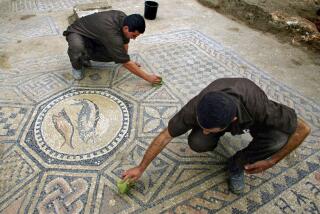Archeologists Debate Ways to Save Ancient Treasure : Sphinx Still a Riddle for Egyptians
- Share via
GIZA PLATEAU, Egypt — After a year of scientific debate, archeologists still can’t figure out how to keep the Sphinx from falling apart.
It’s been almost six months since workmen made emergency repairs and replaced a stone that fell Feb. 7, 1988, from the crouching lion’s right shoulder.
But the experts can’t decide what to do next.
“Scholars from Egypt and around the world have given us good advice, but not one has been able to come up with a sure way to save our wonderful Sphinx,” said Sayed Tawfik, Egypt’s top archeological official.
As chairman of the Egyptian Antiquities Organization, Tawfik is caretaker of Egypt’s enormous treasures of the past.
Only One Sphinx
“In all the world there’s only one Sphinx like this,” he said. “We love him and don’t want to do anything to injure him. This is why we have an international panel studying where to go from here.”
The Sphinx, with its wide-eyed stare and smug expression, has undergone the jabs and probes of restorers almost since anonymous artisans sculpted the half-man, half-beast 4,600 years ago at the base of Giza’s pyramids plateau.
None of the intermittent remedies has been able to stop occasional rock falls.
Major falls touch off political uproars in Cairo.
A tumbling rock in 1982 cost the antiquities chairman at that time his job.
Last year’s rockfall brought the departure of Ahmed Kadry, pressured out of office because of a vocal and highly public row with his boss, Farouk Hosni, the minister of culture. Tawfik was appointed to replace him in December.
Such sensitivity illustrates the Sphinx’s monumental importance to the Egyptians. Ancient Egypt was a cat-worshiping country, and the Sphinx remains a very personal and popular cat.
Bruised, Battered Relic
At times mostly buried in desert sand, at times not, the Sphinx has survived into the late 20th Century as one of world’s best-known relics, although bruised and battered.
Nobody knows how or why or when it lost its nose and Pharaoh’s beard, but they are the most obvious reminders of the unseen stresses at work.
Tawfik said he believes the ancient stonemasons knew the Sphinx wouldn’t survive as long as the pyramids of Giza, which form a backdrop against the horizon.
Some of the Sphinx’s building blocks are as strong as those of the pyramids, he said, but others, especially in the neck, shoulder and rear haunches, are weaker.
“Perhaps they knew after 4,000 years or so the Sphinx couldn’t survive any longer,” said Tawfik, an archeology professor. “I think the Sphinx is a decoration of Giza Plateau, a unique one, not a monument for eternity as were other monuments.”
The first known effort to help the Sphinx was 3,400 years ago. As recorded in stone, the prince who would become Pharaoh Tuthmosis IV followed an order that came to him in a dream during a daytime nap to remove the sand from the Sphinx. He did so and, as promised in the dream, the Sphinx repaid him by arranging for him to usurp the throne of Egypt.
Emergency Restorations
Fourteen centuries later, Roman technicians performed emergency restorations at a time when the pyramids and the Sphinx already were drawing tourists from around the Mediterranean.
In modern times, foreign and Egyptian teams have had a go at stopping the decay. Applying mudpacks to remove salt clusters and injecting glue down its throat didn’t work. More drastic suggestions such as reburying the monument in sand or encasing it in glass arise from time to time.
In the year since the stone fell, experts from Egypt, Germany, Italy, France, the United States and other countries have given advice on how to proceed.
Egyptian geologists are studying rock samples. Specialists are monitoring desert winds that blast the Sphinx. Pollution experts are studying the effects of dirty air. Water and soil technicians are testing the water table level on and near Giza Plateau, checking whether subterranean water is causing salt to weaken the limestone.
Optimistic Outlook
Even so, the Giza Plateau’s antiquities director, Zahi Hawass, remains optimistic.
“I believe for the first time in its history we are able to save the Sphinx,” Hawass said, explaining that advanced scientific findings in many fields are being applied to archaeological work.
But for the Sphinx, he said, time is passing fast.
“He’s like a suffering old man who needs an operation. But what kind? When the rock fell (last year), it was kind of a red flag,” Hawass said. “At that time the government appointed a committee to decide what to do. We’re still meeting.”
And it will continue to meet, he said, until it comes up with a plan that won’t repeat the earlier restoration efforts that harmed the Sphinx more than they helped.
More to Read
Sign up for Essential California
The most important California stories and recommendations in your inbox every morning.
You may occasionally receive promotional content from the Los Angeles Times.













